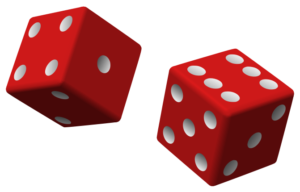Dice Probability Calculator
Probability refers to a measure quantifying the likelihood that certain events will occur. The probability of dice being a particular number is one-sixth. Furthermore, a dice probability calculator is useful in calculating dice probabilities. Students can explore the calculation of dice probabilities here.
One Dice Rolls
The simplest and easiest case of dice probabilities is the chance of getting a particular number with one dice. In probability, the basic rule is that one must calculate it by looking at the number of possible outcomes in comparison to the desired outcome.
Dice presents six possible outcomes. Furthermore, the interest of the individual would be only for one outcome irrespective of the choice of number. A dice probability calculator would be quite useful in this regard.

The formula one may use in this case is:
Probability = Number of desired outcomes ÷ Number of possible outcomes
Therefore, the odds of rolling a particular number, if the number is 6, this gives:
Probability = 1 ÷ 6 = 0.167
Probabilities are available as numbers between no chance and certainty. Furthermore, no chance resembles 0 and certainty resembles 1. An individual can multiply this by 100 to derive a percentage. Consequently, the chance of rolling 6 on the dice is 16.7 per cent.
Two or More Dice
The probabilities certainly get a little more complex to work out when two dice are involved. The calculation of independent probabilities takes place when one wants to know the likelihood of getting two 6s by rolling two dice.
Most noteworthy, the result of one dice does not depend on the result of the other dice.
Independent probabilities have the rule that one must multiply the individual probabilities together to achieve the result. Therefore, the formula for this is:
Probability of both = Probability of outcome one × Probability of outcome two
Total Score from Two or More Dice
If an individual wants to know the likelihood of getting a particular total sore by rolling two or more dice, then one must go back to the simple rule.
This simple rule is probability= number of desired outcomes divided by the number of possible outcomes. Again, the use of a dice probability calculator is crucial here.
Counting the number of outcomes one is interested in requires more work. If an individual desires a total score of 4 on two dice, then this is achievable by rolling 1 and 3, 3 and 1, or 2 and 2.
Furthermore, the individual must consider the dice separately. A 1 on first dice and 3 on other dice is certainly different than a 3 on first dice and 1 on the second dice.
For rolling a 4, there are three ways to get the outcome one desires. Consequently, there are 36 possible outcomes. The work out of this is as follows:
Probability = Number of desired outcomes ÷ Number of possible outcomes = 3 ÷ 36 = 0.0833.
The percentage comes out to be 8.33 per cent. Also, 7 is the most likely result for two dice. Moreover, there are six ways to achieve it. The probability in this case is 6 ÷ 36 = 0.167 = 16.7 percent.
Solved Question For You
Q1 Which of the following statements is not true with regards to dice?
A. The probabilities get easier to work out when two dice are involved
B. The probability of dice being a particular number is one-sixth
C. A dice probability calculator is useful in calculating dice probabilities
D. A dice presents six possible outcomes
A1 The correct answer is option A., which is “the probabilities get easier to work out when two dice are involved”.






I am really appreciate your effort
Thank you all